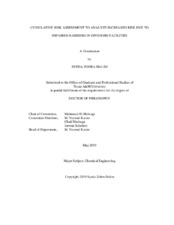| dc.description.abstract | Investigation of past incidents always reveal deficiencies that are not directly equipment-related, but may be non-technical in nature, such as procedural deviation, inadequate communication etc. Past risk assessment models only provide semi-quantitative approaches to incorporate such learning from past incidents and cannot capture their dynamic nature and dependency within a single model. Current research takes up the challenge of developing a novel approach and step-by-step methodology for quantitatively merging technical, operational, human and organizational factors contributing to the cumulative risk of barrier failure. It also addresses their dynamic changes with time, considers interactions among each other and incorporates uncertainty of parameter estimation to assess the total risk.
First, a methodology is developed and implemented for extracting statistical data of contributing factors behind past incidents from investigation reports. The study produces a generic dataset of contributing factors in 137 fire incidents from the US Outer Continental Shelf (OCS). Analysis shows that failures rates of contributors are non-constant and can be modelled as non-homogenous Poisson process with Power Law distribution. Hierarchical Bayesian Analysis is utilized to predict probability of failure within a time period and next time of occurrence from the generic data. Results show reliability growth for contributors related to ‘design flaw’ and ‘inadequate job safety analysis’ in the OCS, although a majority of other contributors show deterioration. In the next stage, near-miss data from a particular facility is incorporated to obtain plant- specific understanding of how and when their next critical failure may occur. Interaction among contributing factors are measured from the analysis of investigation reports. Finally, a cumulative risk assessment model for an offshore unit with safety instruments is developed, where the contributing factors are mapped onto Bayesian Network to provide probability distributions of barrier failure and subsequent incidents. A case study is adopted to show how extracted information from investigations can be utilized to update generic data and obtain probability distributions of individual barrier failure. This research will aid management to identify key organizational issues that contribute to an increased risk of barrier failure, so that better resource allocation can be ensured. | en |


